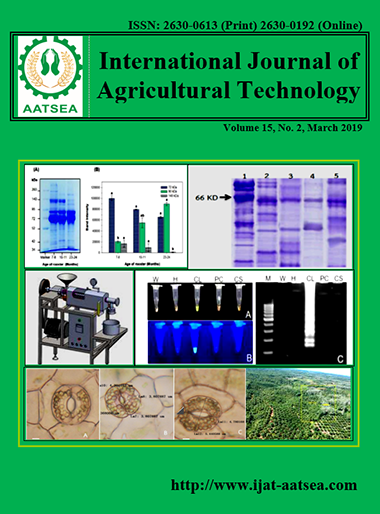The relationship of hematological values with Newcastle disease antibody in Thai indigenous chicken: strain Leung Hang Khao
Main Article Content
Abstract
The relationship between hematological values and Newcastle disease immunity of Thai indigenous chicken was studied in strain Leung Hang Khao which attractive to consumers in Thailand. The blood and serum samples were collected from 153 chickens of this strain (mixed sex: male = 70, female = 83) at 4 and 7 months of age raising in free-range condition. Hematological value of the strain Leung Hang Khao at 4 month of age showed the mean corpuscular volume (MCV) in male (126.80±0.51 fl.) was statistically significant (p<0.05) higher than in female (123.30±0.46 fl.). While, the total red blood cell (TRBC), hemoglobin (HGB), hematocrit (HCT), mean corpuscular hemoglobin (MCH), mean corpuscular hemoglobin concentration (MCHC), total white blood cell count (TWBC), heterophil, lymphocyte, monocyte and H:L ratio were no statistically significant (p>0.05) between sexes at 7 month of age. The average titers were no statistically significant (p>0.05) between sex at 4 month (male: 806.40±97.70 and female: 756.70±87.65) and 7 month (male: 5,372±799.08 and female: 6,561±709.28) of age, respectively. In addition, the hematological values of this strain at 4 month of age was relative to Newcastle disease immunity. The titer was statistically significant (p<0.05) correlation with the hematological value. The titers with the low, medium and high levels of immunity (63.15±23.47, 421.77±28.04 and 1525±131.92, respectively) were negative relationship with lymphocyte (71.00±2.46, 69.79±0.81 and 67.72±1.29 percentages of white blood cell (WBC), respectively) but statistically significant positive (p<0.05) relationship with heterophil (25.17±2.34, 27.76±0.86 and 29.41±1.05 percentages of WBC, respectively). The relationship between the amounts of lymphocyte and heterophil, and Newcastle disease immunity were indicated with the coefficients of phenotypic correlation of -0.17 and 0.18, respectively. From these results showed that, the relationship between hematological values and Newcastle disease immunity could be used as a primary health assessment Newcastle disease index for Thai indigenous chicken strain Leung Hang Khao.
Article Details

This work is licensed under a Creative Commons Attribution-NonCommercial-NoDerivatives 4.0 International License.
References
Alders, R. G. and Spradbrow, P. B. (2001). Controlling newcastle disease in village chickens: a field manual. ACIAR Monograph No. 82. Australian Centre for International Agricultural Research: Canberra. 112:12-13.
Bounous, D. I. and Stedman, N. L. (2000). Normal avian hematology: chicken and turkey. Schalm’s veterinary hematology. ed. BF Feldman, JG Zinkl & NC Jain. pp. 1147-1154.
Campbell, T. W. (1995). Avian hematology and cytology. 2nd Edn, Iowa State University Press, Ames, Iowa, USA.
Duangjinda, M. (2015). Breeding strategies for improvement of global traits in Thai indigenous chicken. Proceeding of International Seminar “Improving tropical animal production for food security” 3-5 November 2015, Universitas Halu Oleo, Kendari, Southeast Sulawesi, Indonesia. pp. 6-14.
Duangjinda, M., Choprakarn, K., Suwanlee, S., Amnueysit, P. and Thieme, P. (2012). Impacts of avian influenza outbreaks on indigenous chicken genetic resources in Thailand. World's Poultry Science Journal. 68:503-512.
Horning, G., Rasmussen, S., Permin, A. and Bisgaard, M. (2003). Investigation on the influence of helminth parasites on vaccination of chickens against Newcastle Disease virus under village condition. Tropical Animal Health Production. 35:415-424.
Jain, N. C. (1993). Comparative hematology of common domestic animals. In: Essentials of veterinary hematology, Jain, N.C. (Ed.). 1st Edn. Lea & Fibiger, Philadelphia, PA., USA. pp. 19-53.
Jaturasitha, S., Chaiwang, N. and Kreuzer, M. (2017). Thai native chicken meat: an option to meet the demands for specific meat quality by certain groups of consumers; a review. Animal production science. 57:1582-1587.
Lumsden, J. H. (2000). Reference values, In Feldman, B.F., Zinkl, J.G. and Jain, N.V., Schalm’s veterinary hematology. Fifth edition. Lippincott Williams & Wilkins. pp. 1120-1124.
Miller, P. J., Estevez, C., Yu, Q., Suarez, D. L. and King, D. J. (2009). Comparison of viral shedding following vaccination with inactivated and live Newcastle disease vaccines formulated with wildtype and recombinant viruses. Avian Disease. 53:39-49.
Parkhurst, C. R. and Mountney, G. S. (1988). Poultry meat and egg production, Van Nostrand Reinhold, New York. pp. 1-15.
Pierson, F. W. (2000). Laboratory techniques for avian hematology. In: Schalm's veterinary hematology, Feldman, B.F., Zinkl, J.G. and Jain, N.C. (Eds.). 5th Edn, Lippincott Williams & Wilkins, Baltimore, MD., USA. pp. 1145-1146.
Simaraks, S., Chinrasri, O. and Aengwanich, W. (2004). Hematological, electrolyte and serum biochemical values of the Thai indigenous chickens (Gallus domesticus) in Northeastern, Thailand. Songklanakarin Journal of Science and Technology. 26:425-430.
Salakij J., Salakij, C., Chaisri, S. and Rochanapat, N. (2004). Hematology, prevalence of Leukocytozoon sp. and microfilaria in Thai and Vietnam fighting cocks (Gallus gallus domesticus). The 4th ASEAN Microscopy Conference and the 3rd Vietnam. pp. 118-122.
Siller, W. G. and Wight, P. A. L. (1997). Anatomy of the Domestic Birds, Verlag Paul Parey, Berlin and Hamburg. pp. 10-202.


